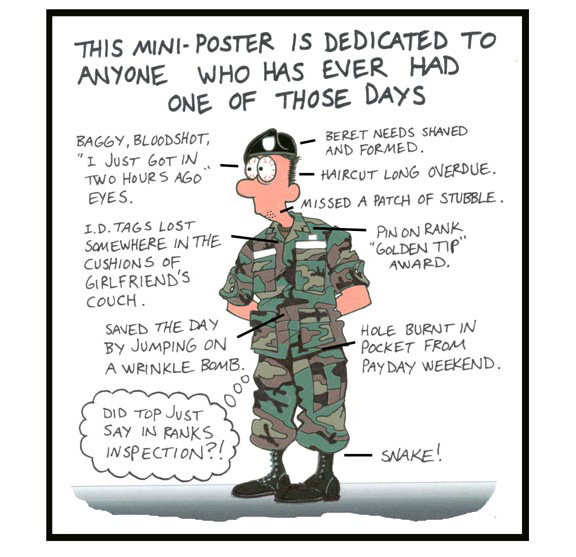MAKE YOUR BDUs LIGHTER AND COOLER
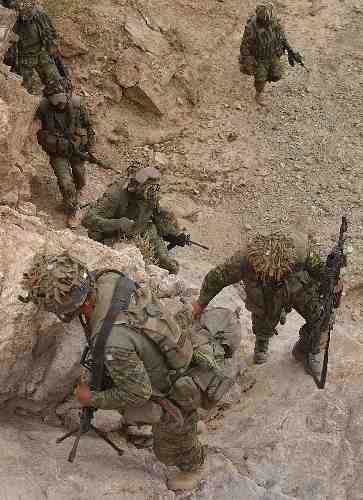
Do-It-Yourself BDU Fixes
The current Battle Dress Uniform (BDU) and Army Combat Uniform (ACU) has too much material making it hot and a source of Soldier heat injuries. It also absorbs moisture and sweat making it work against the extended cold weather clothing system (ECWCS) that seeks to keep the Soldier dry at all times. This is a source of Soldier frostbite/cold weather injuries. About the only thing the BDU does is provide covering for the Soldier in camouflage and abrasion resistance from vegetation. Realizing this, the best that we can do is minimize the heat and cold weather flaws it has.
1. Never starch your BDUs/ACUs--once starched the starch never leaves, creating a uniform that breaths even less, holding heat in and odors. Starching weakens the fabric and ruins the infrared protective coating...unless you a marine with a death wish or working for the enemy, only clean and press the BDU. Don't buy into the narcissistic egomaniac vanity mentality. The regulations do not require you to starch your uniforms, so DON'T. Don't cave in to peer and superior official's pressure--MAKE THEM ABIDE BY THE REGULATIONS when they are good directives.
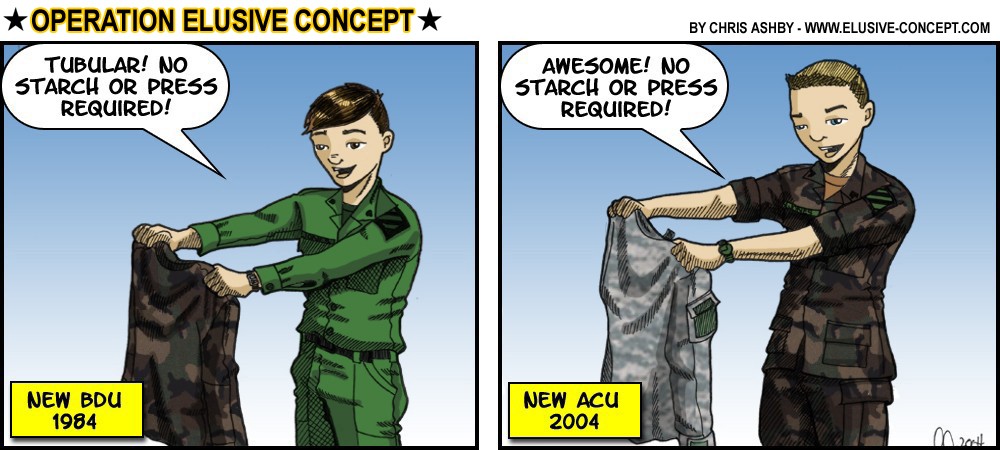
2. Code letter the top and bottoms of BDUs so they fade together--with a permanent black marker, make a letter A, B, C, D etc on the inside bottom of the BDU top and the rear pocket of its matching bottom. This way you will keep them together during wash and wear them at the same time to insure they fade/wear evenly. The coding will also tell you how many BDUs set you have.
3. Remove excess material from your BDUs--remove all laundry tags and size labels. These serve no purpose since you know only to machine wash and dry your BDUs. The laundry tag under the collar is irritating to the neck. If you have different sizes, use the permanent marker to mark the size on the lower right hand corner where you marked the code letter. "SR"=small regular, "MR"=medium regular......etc. On the BDU top, replace all pocket buttons with Velcro, this will improve your low-crawling and when the uniform is pressed eliminate the button bulge from showing (optional).
Remove the buttons that close the BDU top and the extra flap of material that holds the button hole and sew the top together so it is a pullover. This dramatically eliminates the amount of material at the torso that can trap heat and moisture. It also makes the BDU top stronger. Cut under the armpits two ventilation slits to help let heat escape from under the armpits. The IDF uniforms have this feature. On the BDU bottom, remove the front bug flap from your fly. Cut off the side tightening tabs at your waist, that's why you have belt loops to wear your Rigger's belt. These straps don't work and are extra weight. The bottom of the trousers have leg ties, since you tuck your cuffs into your boots, pull on these cords and cut off as much as you can.
4. Sew a small piece of black elastic to form a foot stirrup on the bottom of your trouser cuffs--this will allow you to put your pants on quickly and place your foot into your speed-laced boots with your trouser legs ready to be wrapped by your boots. A small piece of elastic has been proven to be unnoticeable by your sock covered foot. This feature unlike blousing bands and straps does not restrict circulation.
5. Sew a last name tape above the right rear pocket of your BDU trousers to prevent theft.--Your name tape on your trousers also speeds recovery of your uniforms in a group laundry situation.
6. Do not wear underwear when wearing BDU trousers--wearing underwear or even biker shorts traps heat and moisture at the waist and groin area, creating conditions for fungal growth unless you are the designated unit far side river bank swimmer, you need not to wear swimtrunks under your BDUs, in fact you could strip to just BDU trousers and swim across to reduce the amount of your uniform that gets wet. Your legs seeing as they are constantly moving in the infantry (HA! HA!) they will quickly dry out from muscular heat. It is lower circulation areas (feet, hands, chest) that need to stay warm.
7.Remove the pocket holder piece of material in the top pocket of the BDU top since its not needed and extra material.
8. Wear summer weight BDUs all the time--the only time you should where the winter weight BDUs is when it is really cold. Since the insulating layers and jackets that you wear that keeps you warm in cold weather, there is no reason why the U.S. Army couldn't standardized on just one type of BDU that is light as possible.
Now, the reader might be asking himself, "WHY DOESN'T THE ARMY REMOVE ALL THIS EXCESS MATERIAL IN THE FIRST PLACE?".
Because the Army PUT IT THERE IN THE FIRST PLACE! The BDU and ACU were "designed-by-committee" for example when the brigade in Panama wanted drawstrings on the pant legs, EVERYONE else in the Army got them, too! Then someone wanted a pen pocket holder...you get the idea. However, the 1st Tactical Studies Group (Airborne) did make the suggestion to the Army and never got a reply.

9. Obtain a set of Nomex, fire resistant BDUs for combat and Airborne/vehicle operations use.--some of the 23 paratroopers that died at the 1993 Pope AFB crash would have lived had they been wearing Nomex(c) Aircrew BDUs. These uniforms have national stock numbers (NSN) and can be ordered through the supply system. NSNs are: 8415-01-328-8253 for the jacket, 8415-01-328-8269 for the trousers. There is no reason why Nomex(c) BDUs couldn't be put on sale at the Army Air Force Exchange System (AAFES) clothing sales stores. So the individual Soldier could buy his own set.
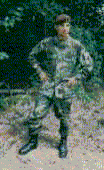
For fire protection, Nomex(c) BDUs need to be issued to all Soldiers to counter the fire risk from wearing synthetic insulating materials like Gore-tex(c) and polypropylene, especially those parachuting from aircraft, clearing mines, standing upright from AFV hatches and those on dismounted patrols near urban areas. Their NSNs are: 8415-01-328-8253 for the jacket, 8415-01-328-8269 for the trousers. For jump padding, cut an unused piece of the issue sleeping mat, and slip into the backside of your Nomex(c) BDUs knees and elbows.
Found this on a website. For the fiscally challenged or anyone who can't convince the boss that fire is bad. Certainly cheaper than Nomex....
Make clothing flame retardant.
Mix together nine ounces 20 Mule Team Borax and four ounces boric acid in one gallon water. If the article is washable, soak in the solution after final rinsing, then dry. If the garment is not washable, spray with the solution. This solution, recommended by fire departments, may wash out of clothing and should be used after each washing or dry cleaning.
These steps if taken above can remove about a pound of weight from your BDUs and minimize the negative aspects they have. The new nylon-cotton hot weather BDU, while more durable is not as cool as the 100% cotton rip-stop BDU. Obtain as many sets of the 100% cotton BDUs while you can. I'd like to say remove the two lower top pockets which are usually covered by LBE/TLBV to enable a tuck-in wear feature for rappelling/parachuting, but we have to look like everyone else. It is my hope that some day a simplified BDU without all these extra materials be issued to Soldiers and without the two lower jacket pockets. There is work underway to create reversible camouflage BDU with day desert on one side and woodland camouflage on the other for rapid-response to world troubles without having to spend precious time issuing different color uniforms. Such chameleonic capability would also help troops as they maneuver across the battlefield and encounter different colors so as to better remain undetected by the enemy.
The U.S. Army has the best way to wear the BDUs. Rolling the sleeves up into a quick-release cuff is tedious, but worth it when you need to go sleeves down compared to the marine bone-head roll-up which you have to fight to undo. Blousing the boots with bands, springs is another jarhead ego trip which is not functional that is avoided. What matters in WAR is victory, not image or grabbing media camera attention. BDUs can be air-delivered along with all the fighting vehicles and equipment needed by Soldiers/Paratroopers--in their case without parachutes using freedrop techniques utilized during Operation Provide Promise, the food/clothing/medical supply missions that saved the Bosnian people from certain death until ground peacekeepers put an end to the killing.
The Continuing Saga of the Reverse Camouflage BDU
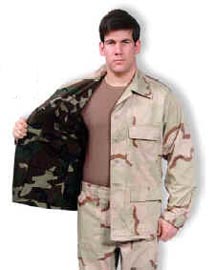
Reversible Battle Dress Uniform (BDU)
Overview: Research and development efforts in the area of textile printing now allow successful printing on both sides of the fabric without colors bleeding through. Two fabrics have been successfully produced: 50/50 Nylon/Cotton twill for temperate environments and 50/50 Nylon/Cotton ripstop poplin for hot weather environments. Possible combinations of front & back print include Woodland/Desert, Woodland/Urban, Desert/Urban, and any print with Arctic Snow Camouflage.
Benefits of reversible BDUs include:
Decreased deployment time
Flexibility in adapting to changes in mission scenario, e.g. airdrop into a desert environment and subsequent maneuvers in a mountainous/woodland terrain
Provide equivalent comfort to standard BDUs
Reduced burden on logistics system, and reduced logistics costs
Reduction in number of items issued to Soldier
Status: Design modifications include pass-through pockets, double pocket flaps, hinged front fly, double buttons on coat and trousers, and reversible labels. Prototype coat and trousers weigh a total of 5.5 ounces (5% more than current BDUs). Alternate construction methods are being explored to reduce weight. Other items for potential reversibility are helmet and pack covers. Reversible BDU test items are being produced for testing with the U.S. marine corps. -----------------------------------------------------------
Last Update: 1 April 2003
You can learn a lot about military equipment by browsing through an Army surplus store since the "mother may I?" Army and marines want you to be in the dark about the nature of our profession so as to not question their shoddy orders and plans. We have a volunteer military full of non-professionals who do not know a lick about living in the outdoors nor about weapons or ground combat vehicles. "The Battle Against the Earth" is not even on their "radar screen" as there is no formal training or institutionalized knowledge to support that training that is passed on so everyone has a "reality check". The only "reality check" in the U.S. military is reality itself after its killed or ruined people for life. ALL Soldiers should learn from their basic training the realities of the Battles against the Earth and Man. To do this, we need to cut out ALL of the draftee, you-are-feces barracks games, rite of passage BS and focus on ONLY what is relevant for surviving and prevailing in COMBAT.
1985
One of the things you discover at a surplus store IN THE PAST SOMETIMES THEY HAD BETTER EQUIPMENT THAN YOU HAVE NOW. This may rain on our technohubris, but its true. 1st Tactical Studies Group (Airborne) Director, Mike Sparks' good friend, National Guardsman, SSG Ernest Hoppe one day in 1985 while they were both in college showed him a REVERSIBLE GREEN & BROWN helmet cover for the WW2-era M1 "steel pot". Further research showed that there were REVERSIBLE CAMOUFLAGE UNIFORMS that marines used to wear in order to be better camouflaged in either dry or wet terrain types. The only cultural memory is a mocking "brown side out!, green side out!" fuck-fuck game where egomaniac marines play boot camp with subordinates and have them run into formation in one color showing then change their minds and have them run inside a building and switch over to the other color because they are dictatorial assholes with too much power to abuse.
Still, a few years later, during Desert Storm when Saddam Hussein's Army was poised to smash into Saudi Arabia, the 82nd Airborne was sitting and unable to deploy because the Defense Logistics Agency (DLA) didn't have enough chocolate chip desert BDUs (designed for the terrain of Iran) to outfit them. After a bit of desperation scrounging, enough uniforms were found, the 82nd flew in and set up the "Desert Shield" with Paratroopers, M551 Sheridan and M113 Gavin light tanks and Saudi Arabia was saved. However, NONE of this delay would have happened if the BDU was REVERSIBLE CAMOUFLAGE in the first place.
1992
Examining the reversible M1 helmet cover Ernie had got for us, we noticed IT WAS TWO PIECES OF MATERIAL SEWN TOGETHER. Ok, that would be hot to wear, but the helmet is a solid non-breathable object anyway, so why not AT LEAST the helmet cover being reversible? So we wrote in to make that suggestion. Here is the startling reply we got:
Natick Labs
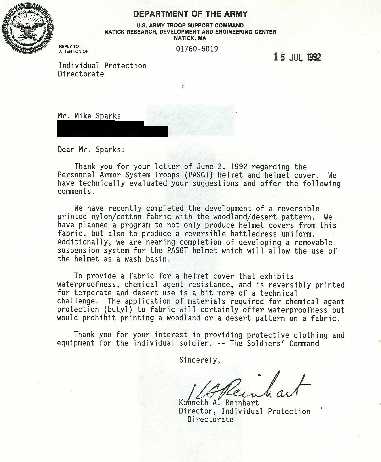
Amazingly Natick Labs had discovered a way to PRINT TWO CAMOUFLAGE COLORS ON BOTH SIDES OF ONE MATERIAL. This was and still is a huge breakthrough, lightening the Soldier's load, improving his tactical function so he can instantly adapt to the terrain as he finds it, speeding deployment of units. 3 years go by nothing happens. We decide to alert both Army Materiel Command and U.S. Special Operations COMmand (USSOCOM) about this technological breakthrough since the former has the clout and the latter has not only money to buy things out of the ordinary and set precedents, they seemed to WANT TO DO WHATEVER IT TAKES TO WIN. As this story unfolds you will see tragically, that even this is not enough. Here is the first reply we got from Lieutenant General Prather, U.S. Army:
U.S. Army Materiel Command
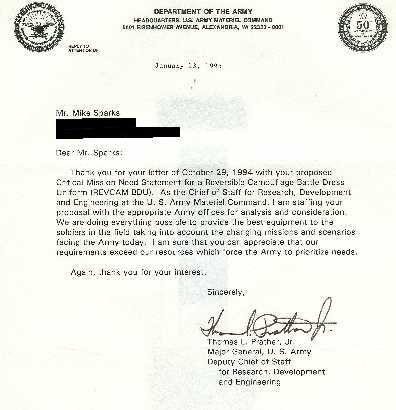
USSOCOM had at the behest of its commander, General Wayne Downing created a "CINC'S Initiatives Group" which would field good ideas from the troops and hopefully act on them. There is hope.

As the days wore on, the suggestion was "staffed" and the bureaucratic layers weighed in on the issue, first Army Special Operations Command (USASOC):

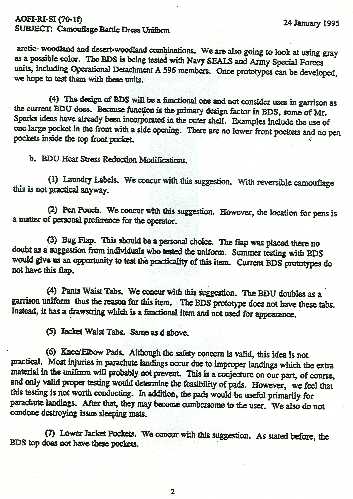
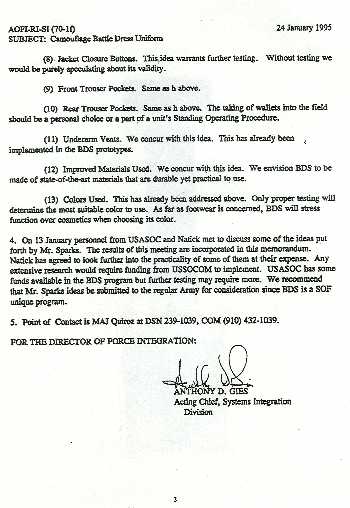
The USAF special operators thought it was a good idea, too

The general consensus as you read the letters above is that USSOCOM has its own private uniform project going "BDS" and they will utilize reversible camouflage fabric, a "REVCAM BDS". However, its up to DLA to get on board with a "REVCAM BDU" to make it service-wide. Some wimping out about whether USSOCOM can go with their own uniform etc. Sparks gets a thank-you-o-gram from CINC'S INITIATIVE GROUP saying all is well.
But all was NOT well.
BDS got cancelled. USSOCOM would continue to wear the uniforms everyone else wears, results be damned.
DLA did not get on board with the REVCAM BDU because DLA gets a cut of the money for every item they stock. In other words it NOT IN THEIR FINANCIAL, CORRUPT BUREAUCRATIC INTEREST TO ADVOCATE ONE UNIFORM DOING THE JOB OF TWO. They will lose, money, power and prestige if they did that. Fuck the troops. They can wear what we give them regardless if it makes them an easier target for the enemy to kill. And this is EXACTLY what later happens.
Now fast forward 10 years.
Operation Iraqi Freedom commences and the show-string force sent in not only lacks applique' armor and gunshields for its M113 Gavins and M2 Bradleys, the troops lack Interceptor Body Armor with hard plates to stop AKM bullets, the PASGT flak jackets they do have, and the lucky ones who do have IBA are WOODLAND GREEN CAMOUFLAGE IN TAN DESERT IRAQ. A huge clusterfuck takes place at the mobilization sites re-outfitting troops with 3-color desert camouflage uniforms (DCUs) shortages are so severe some entire units like the 4th Infantry Division go to war in their woodland camouflage BDUs and take the resultant casualties. All of this could have been prevented had we adopted REVCAM BDUs 10 years before, or at the very least an UNIVERSAL BROWN camouflage color. Load Bearing Equipment (LBE) known as "TA-50" and "782" gear in Army/marine parlance still come in absurd olive drab which ruins the camouflage effect of DCUs even if you wear them. ALL LBE should come in an universal BROWN or tan to work with either woodland camouflage or desert camouflage uniforms. How many of our Soldiers have died due to bad camouflage? You read in-between the lines:
American Iraq War Casualties 2003-2004
www.combatreform.org/MILITARYINCOMPETENCE/americaniraqwarcasualties.htm
However, again we point out that LESS ITEMS DOING MORE MEANS LESS ITEMS DLA STOCKS WHICH MEANS LESS MONEY AND POWER FOR THAT CORRUPT BUREAUCRACY.
Clearly, Congress should abolish DLA as a hindrance to equipment progress to our Soldiers and an un-needed bureaucratic layer of getting good gear to the good guys.
Where does REVCAM stand now?
The USMC absurdly went to a digital woodland green and a digital desert camouflage pattern = two uniforms that have to be carried around by the marine and added costs all around for the organization and the individual. The USAF is going with a silly "A-Team" Vietnam-era tigerstripe pattern in BLUISH-Gray-green hues. On their heads was to be a USMC-style "train conductor" cap but they got smart and decided to not look like morons. They will look like partial clowns. The Army with a decent beret to look sharp and raise morale had ties to the old BDS project in USSOCOM will have a new uniform with some decent functional features called the Army Combat Uniform (ACU) that instead of reversing its colors tries to get by with one universal weird gray camouflage pattern. We hope it works. It looks too dark in our opinion for desert areas.
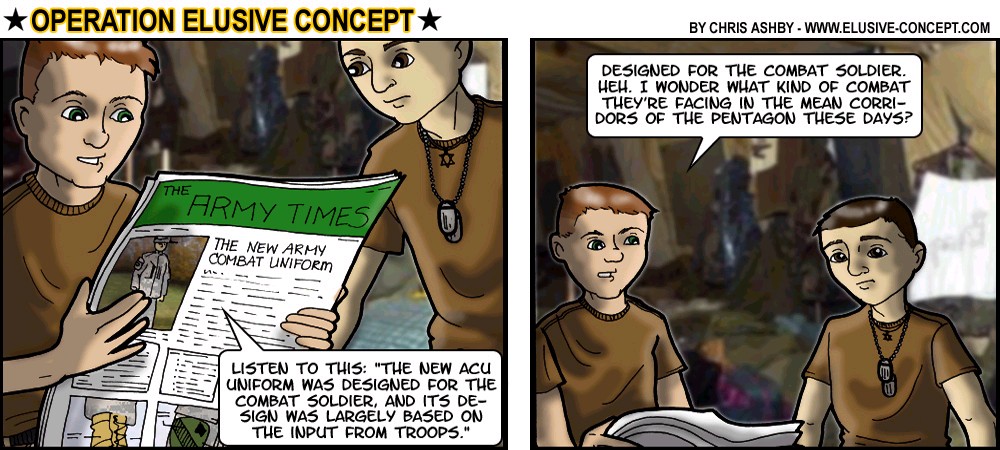
New Army ACU: is it too dark?
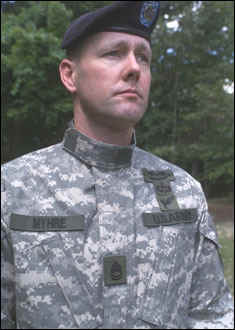
Video detailing the new Army Combat Uniform: www.ngb.army.mil/news/2004/06/newacu.wmv
The ACU is not without good features. They are:
1. Gets rid of jacket lower pockets
2. Eliminates black boots that need to be shined, a huge fire safety hazard, tactical camouflage eye sore, a time waster we can ill afford on today's lethal, non-linear battlefields
3. Replaces flimsy web belt with TAN Rigger's belt that is life support capable
4. Stops having branch insignia sewn on the collar to polarize "us" and "them"
5. Discourages egomaniacs to wear their HOOAH! badges because recent policy is to use pin-on black metal ones
(disregard picture here on web page)
6. Shoulder pockets are very useful so Soldiers don't have to add their own
7. Lower pocket can carry a 30-round rifle magazine
8. ACU patrol cap has last name/cateyes as standard
9. TAN t-shirt slightly cooler than BROWN in hot weather
10. Encourages infared glint tape squares to be worn to improve Identification, Friend or Foe (IFF)
11. Encourages wear of blood type patch to facilitate medical care if wounded
However, we still think the answer is to realize dry and wet areas require two camouflage patterns and that a REVCAM "ACU" is still needed. Maybe if enough Soldiers die this will make the milocracy to act. Maybe not. They will conveniently use patriotism and smokescreen their incompetence by how great heroes these men were deceiving us from the fact that if they were properly equipped and led they could have been LIVING HEROES instead of dead ones.
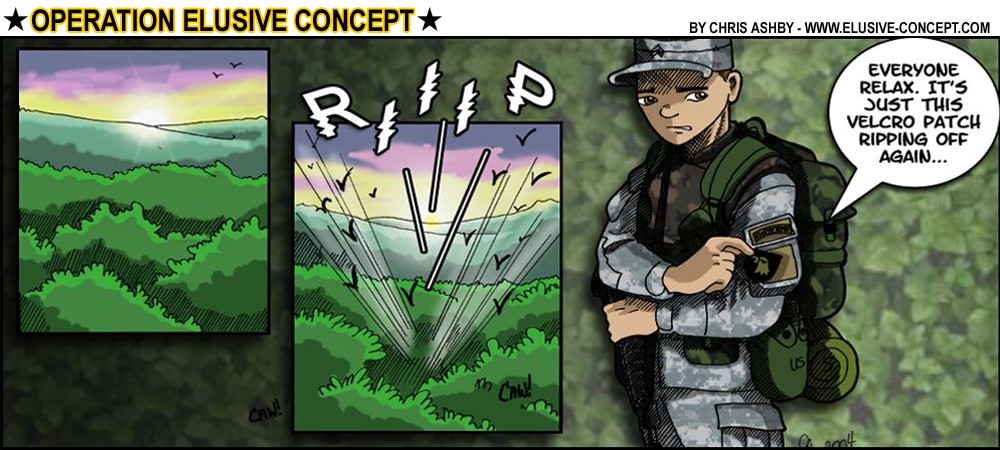
IMMEDIATE FIX OF ACU BAD CAMOUFLAGE: BUY MULTICAM BDUS: Army ACUPAT camouflage flunks in combat--Multi-Cam to the Rescue
ACU in Digipat BAD:
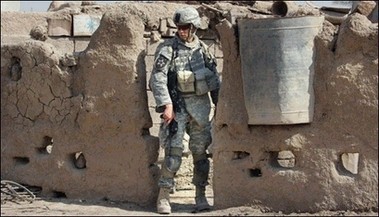
ACU in Multi-Cam GOOD:
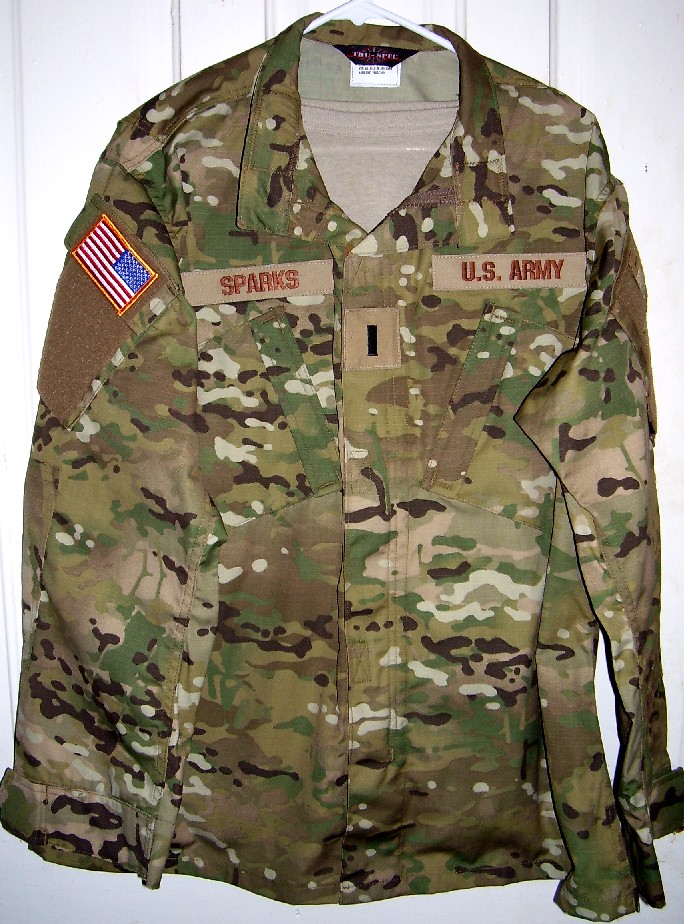
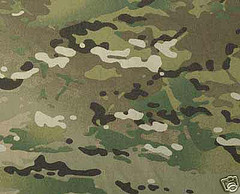

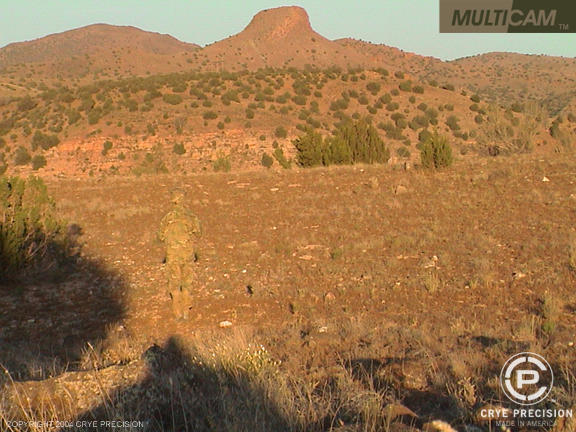
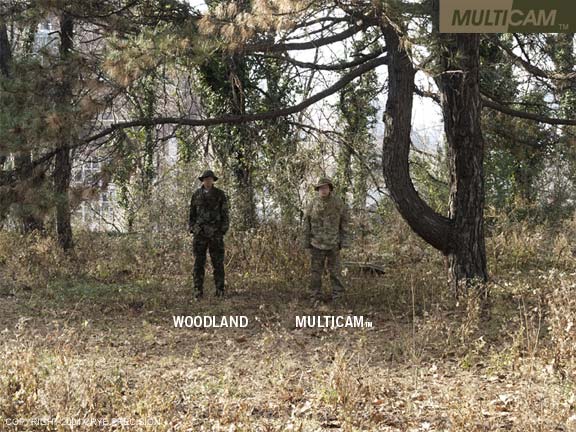
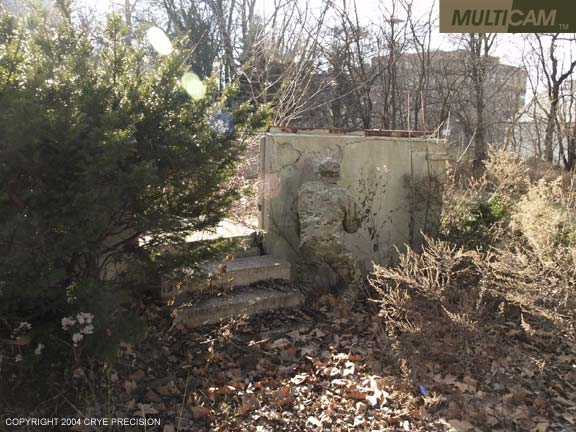
www.youtube.com/watch?v=JOCq0E3LwsQ
Above is how the multicam TRU should be sewn up with khaki name and organization tapes and rank to appear as kosher as possible to 1SGs and to be labeled as not a contractor. What should matter most is being CAMOUFLAGED and hard to hit. Art Criss of Commandos in Columbus, Georgia is having multicam ACU-style patrol caps made, too. An official Army ACU patrol cap maker, SEKRI is willing to make them in multicam (606) 528-7490 or jim.page@sekri.org.
Multicam Emergency Camouflage for the Deploying Soldier
www.multicampattern.com
Why multicam works best in all environments, mix/match with desert camo accessories, they work well together
www.vtarmynavy.com/lti.htm
MC Helmet cover
MC TRU shirt $55
Patches/Sewing to match ACU style $20
MC TRU pants $55
knee pads $27
MC IBA cover $440
MC patrol cap or boonie hat $16
___________________________________
Min $188 (you'll have IBA ACU torso)
Max $629 completely covered in multicam
www.ar15.com/forums/topic.html?b=6&f=10&t=221776&page=1
Crye Precision sells the following grades of fabric:
330 Denier Cordura
500 Denier Cordura
725 Denier Cordura (currently out)
1000 Denier Cordura (currently out)
MULTCAM HT NYCO (Think MCCUU Trouser Fabric - currently out)
MULTICAM LT NYCO (Think MCCUU Jacket Fabric)
MULTICAM NYCO Ripstop (Think ACU Uniform material)
In addition; the CB buckles and hardware can be purchased through another retailer, The Supply Captain (www.supplycaptain.com); all I'd need would be someone with some modest skill with a heavy dury sewing machine and some heavy duty threading and we'd be in business.
(Sure beats trying to get someon ein Hong Kong to make them, but then you'd have to deal with a "Minimum of 100 sets per order" requirement.)
http://store.nexternal.com/shared/StoreFront/default.asp?CS=armynavy&BusType=BtoC&Count1=827907741&Count2=745048165&ProductID=4962&Target=products.asp
MultiCam KEV Helmet Cover
Now the most innovative uniform on the market is teaming up with the most innovative camouflage on the market!
MultiCam is a single camouflage pattern designed to help the wearer hide in varied environments, seasons, elevations and light conditions.
It was designed to address the real-world need for concealment in different environments, with one basic kit of gear.
HOW IT WORKS:
Takes on the shade of the surrounding environment by adapting to varying local lighting conditions, the pattern blend in well in many environments, elevations, seasons, weather conditions and times of the day.
Since only a small portion of the human eye perceives color, the brain does a lot of "filling in" for the eye. MultiCam takes advantage of this principle and helps the observer to "see" the pattern as part of the background.
MultiCam relies more on a blending effect than a contrast effect to disguise the wearer. This effect allows it to perform in a wide range of environments and keeps the pattern effective even at close distances.
~ Made of 50/50 Vat Dyed Nyco Rip-stop Material
http://store.nexternal.com/shared/StoreFront/default.asp?CS=armynavy&BusType=BtoC&Count1=827907741&Count2=745048165&ProductID=4962&Target=products.asp
MultiCam Helmet Cover - MICH
Now the most innovative uniform on the market is teaming up with the most innovative camouflage on the market!
MultiCam is a single camouflage pattern designed to help the wearer hide in varied environments, seasons, elevations and light conditions.
It was designed to address the real-world need for concealment in different environments, with one basic kit of gear.
HOW IT WORKS:
Takes on the shade of the surrounding environment by adapting to varying local lighting conditions, the pattern blend in well in many environments, elevations, seasons, weather conditions and times of the day.
Since only a small portion of the human eye perceives color, the brain does a lot of "filling in" for the eye. MultiCam takes advantage of this principle and helps the observer to "see" the pattern as part of the background.
MultiCam relies more on a blending effect than a contrast effect to disguise the wearer. This effect allows it to perform in a wide range of environments and keeps the pattern effective even at close distances.
~ Made of 50/50 Vat Dyed Nyco Rip-stop Material
Multicam Tactical Response Uniform (equivalent to ACU)
Multicam IBA carrier
http://tacticaltailor.com/index.asp?PageAction=VIEWPROD&ProdID=278 Product Details
Please Note: Large size IBA Carriers are temporarily out of stock. We expect to have additional stock on or around 9/13/07.
We took the issue IBA carrier and designed our own armor carrier based on recommendations and requests from our customers. Add comfort and functionality while maintaining the requirement that you wear your issue armor. Our IBA is not an armor system, we carefully designed it using Interceptor soft armor and SAPI plates so it meets the stringent government requirements. We also took the many complaints we heard about the IBA and designed our vest to improve them. Modular webbing covers the front and back, adjustable shoulders help prevent your vest from digging into your neck in the front and pushing your MICH down over your eyes from the back and aids in removing the armor in an emergency. The integrated cummerbund secures the back panel to the torso, distributing the weight more evenly across the shoulders and back, reducing fatigue. Adjustable sides ensures proper fit, regardless of clothing layers to meet your mission requirements. Velcro panels on the front and back allow attachment of nametapes or patches and double as modular webbing. Also features field repairable buckles, drag handle, and hydration loop on shoulder.
NOT AN ARMOR SYSTEM. REQUIRES IBA SOFT ARMOR AND HARD PLATES.
Available Colors: ACU, MC
Price: $400.00
(253) 984-7854
order through custom shop
584-5500
Tactical Tailor
2916 107th Street South
Lakewood, WA 98499
$400+40
www.optactical.com/tataibaca.html
Multicam Kneepads
www.skdtac.com/index.asp?PageAction=VIEWPROD&ProdID=824
Alta MultiCam Superflex Exclusive THE BEST DAMN KNEE PADS AVAILABLE- PERIOD.
List Price: SKD Price: $27.50 Availability: Y
http://store.nexternal.com/shared/StoreFront/default.asp?CS=armynavy&BusType=BtoC&Count1=827907741&Count2=745048165&ProductID=4962&Target=products.asp
MultiCam Uniform Boonie Hat
Now the most innovative uniform on the market is teaming up with the most innovative camouflage on the market!
MultiCam is a single camouflage pattern designed to help the wearer hide in varied environments, seasons, elevations and light conditions.
It was designed to address the real-world need for concealment in different environments, with one basic kit of gear.
HOW IT WORKS:
Takes on the shade of the surrounding environment by adapting to varying local lighting conditions, the pattern blend in well in many environments, elevations, seasons, weather conditions and times of the day.
Since only a small portion of the human eye perceives color, the brain does a lot of "filling in" for the eye. MultiCam takes advantage of this principle and helps the observer to "see" the pattern as part of the background.
MultiCam relies more on a blending effect than a contrast effect to disguise the wearer. This effect allows it to perform in a wide range of environments and keeps the pattern effective even at close distances.
~ Made of 50/50 Vat Dyed Nyco Rip-stop Material
Multicam Patrol Cap
www.sekri.org/returns.htm
Returns and Exchanges
At Southeastern Kentucky Rehabilitation Industries, our concern is your satisfaction with both our service and our quality products. For this reason returns, credits and exchanges are allowed with some restrictions. You can exchange items within 10 days of purchase for any manufacturer's defect, damaged merchandise or for any error on our part (e.g. wrong size, color, style, etc.). Please note that we reserve the right to inspect the item and/or order before issuing a new item.
Returns, credits and exchanges are not allowed for any of the following reasons:
Merchandise in your possession for more than 30 days
Items that have been used, worn or washed
Returns, credits and exchanges are allowed in all other circumstances with a 20% restocking fee.
Send returns to:
Southeastern Kentucky Rehabilitation Industries Inc.
201 Opportunity Dr.
Corbin, KY 40701
Please use care in sending items back to us, preferably shipped and packaged in its original container. We cannot accept damaged items. Note also that shipping and handling charges are not refundable. For questions about our returns policy, call us at (606) 528-7490 or e-mail us at jim.page@sekri.org
ACU Identifiers
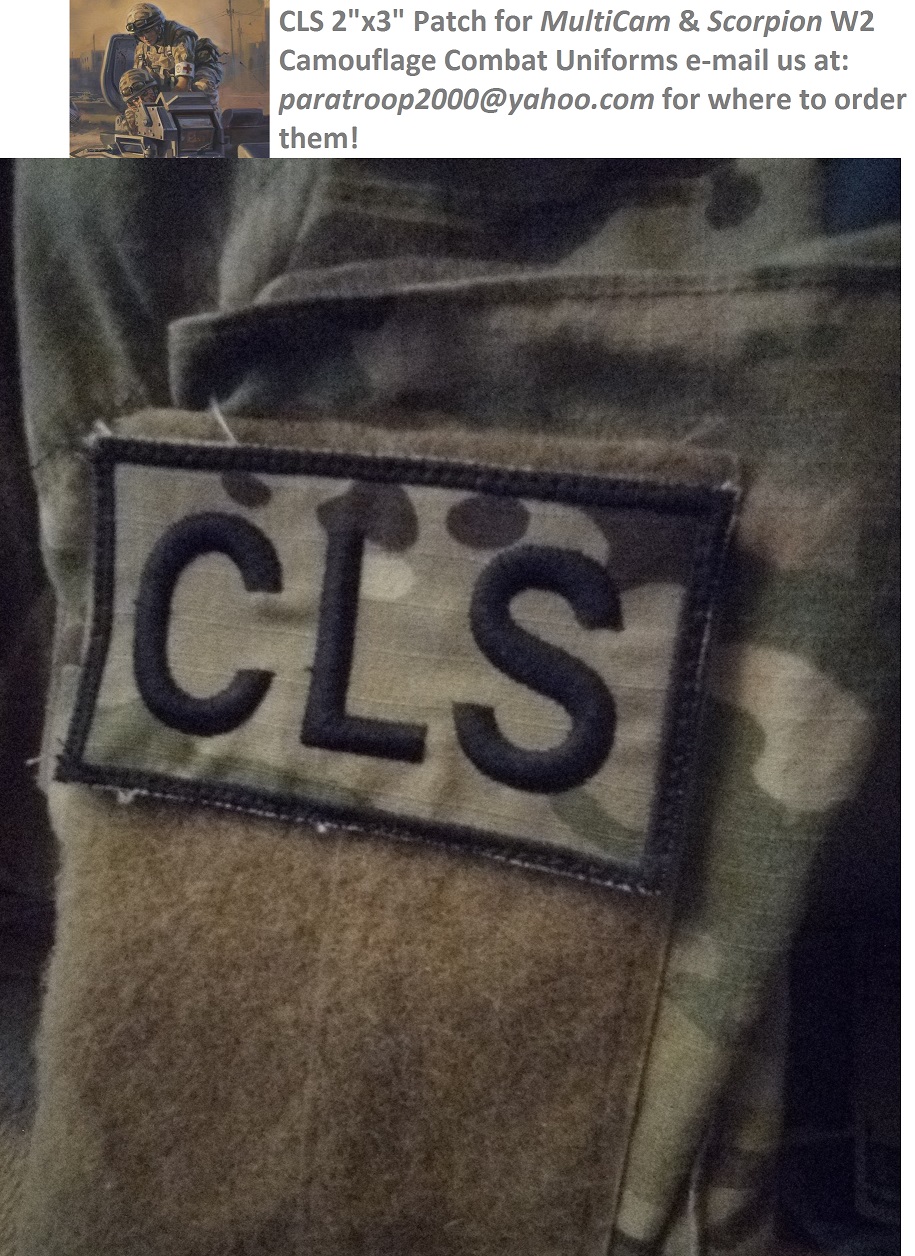
"A picture is worth a thousand words"
One of my favorite scenes in the film, The Dirty Dozen is when they are in war games against the "Blue Force" and they keep changing their arm bands from red to blue and back again to deceive the enemy and capture a command post.
 www.youtube.com/watch?v=Ob1x-dRlKN4
www.youtube.com/watch?v=Ob1x-dRlKN4
With the ACU's velcro on both shoulder sleeves its now possible to stick on and peel off not just colors but important information to identify the Soldier for command & control in the dark WITHOUT WORDS OR WHISPERS and to note his medical condition in detail without fumbling around with casualty cards. During the war practices leading up to the operation, the ACU's velcro insignia holding feature can instill a greater sense of purpose within units and individuals as their roles and functions are readily visible to all like a football team's numbers for the back field quarterbacks 0-20, running backs 21-44, linemen 45-80, receivers 81-99 etc.
Position Identifier
 www.youtube.com/watch?v=vZ1w4mmVZ40
www.youtube.com/watch?v=vZ1w4mmVZ40
Ranger Joe's offers an ACU cover-up kit consisting of two small 2x4" and two large 4x4.75" clear patches of ACU material with velcro backing that when applied to the soft side velcro covers it up completely to eliminate it getting dirty and wearing out. The two small cover-up pieces are for the left and right top pocket flaps.
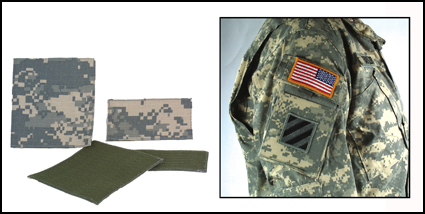
www.rangerjoes.com/acu-digital-patch-cover-kit-p-3274.html
Usually the American flag covers up the right top pocket flap and a unit combat service patch below it. What we can do for the LEFT top pocket cover flap is take ACU nametape embroidery and turn the cover-up flap into a POSITION IDENTIFIER.
Here is an example of a Combat LifeSaver:
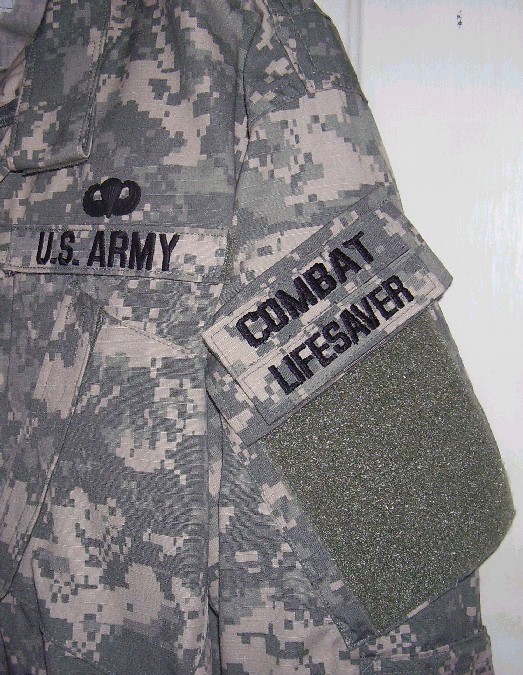
And a Medic in Iraq:
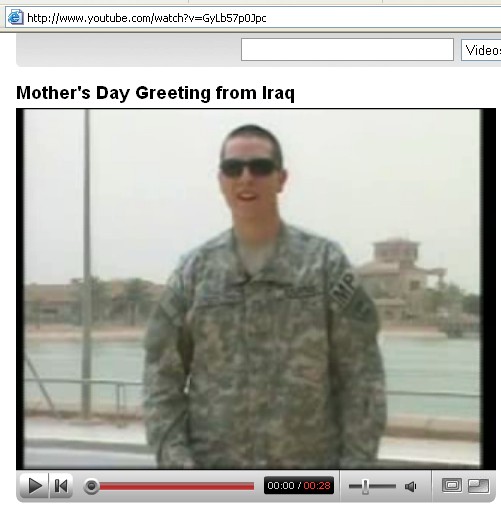
And with the lower velcro covered by the large clear ACU patch.
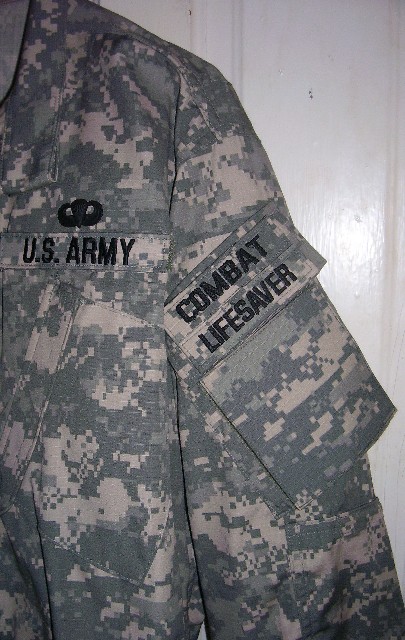
One of the problems I've encountered consistently through my 28 years as an enlistedman and officer is marines and Soldiers not taking their job seriously because its got no outward visibility--and hence no group esteem. Without this, CLS skills will be eroded by corrupt bureaucrats like the recent HQDA decision to rob I.V. training from the curriculum that will MURDER OUR MEN in combat when their blood vessels collapse and go into systemic shock:
 www.youtube.com/watch?v=VAz4ocpMPgI
www.youtube.com/watch?v=VAz4ocpMPgI
We can and we must change this by using the ACU's left top pocket flap as a POSITION IDENTIFIER like "Medic", "Combat LifeSaver" etc. In fact, if a CLS or a Medic saves a life, they can take a black pen and make a tally mark on the clear ACU material somewhat like we do in football when we score a touchdown, make a tackle etc. and place a sticker on the helmet.
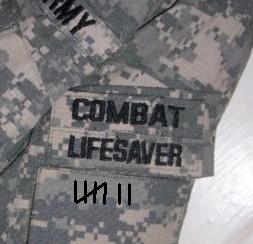
This would encourage Soldiers to save lives and honor those who do with some eyeball peer recognition.
We can even go beyond this to show LEADERSHIP assignment. For example:
SQUAD LEADER
1-A CO 1-504 PIR
This means he's a SQUAD LEADER of 1st Platoon, Alpha Company, 1st Battalion of the 504th Parachute Infantry Regiment (1st Brigade of the 82nd Airborne) . Thus, during war practice EVERYONE can see what his role in the overall scheme of things and he can take some measure of the importance of his task since its not hidden. Grenadiers who are to employ the 40mm grenade launcher under the M16/M4 rifle/carbine are constantly not taking their job seriously as grenade-carrying vests or MOLLE grenade pouches sit in the supply room unused or not purchased/ordered since the Army doesn't value the GL enough to create a non-lethal nerf sponge type 40mm round with marking powder that can be shot during war practices so it gets tactical play along with the kinetic energy bullets simulated by MILES laser tag.
During actual combat operations having position identifier information on the shoulder sleeve at night can enable leaders at the assembly areas after a parachute jump or helicopter insertion to rapidly identify who-is-who without having to talk or whisper. The position identifier patch also tells roughly what the Soldier is capable of doing well if units have to be formed from scratch due to a lack of personnel. If its feared the enemy's snipers can read the position identifier info on the patch to better determine who to shoot at or not shoot at, then during the day time the position identifier patch is peeled off and placed in the ACU pocket. In this case the vital function of letting we ourselves know what we are doing would be the benefit gained by wearing the position identifier during war practice.
Location/Task Identifier
 www.youtube.com/watch?v=n289Uq4pQzQ
www.youtube.com/watch?v=n289Uq4pQzQ
Unit Patch is Sewn or Velcroed under the Clear Plastic and visible when Indentifier Cards not in place

 www.youtube.com/watch?v=8aKRFMtSihc
www.youtube.com/watch?v=8aKRFMtSihc
Solid Colors Like French Foreign Legion Does with Arm Bands


Black Marker can be used to write Information directly onto the plastic or on the card underneath...

Sample Black Marker Hand-Written Task ACU Identifier Cards

Under the top pocket flaps of the ACU sleeves is a very large square of soft "loop" velcro for the Soldier's unit patch. Rarely is this entire square taken up except with the humongous 1st Cavalry and 2nd Infantry's patches so velcro is exposed to the elements and the terrain/vegetation. By covering up these large patches we solve the wear-out and patch coming-off-when-snagging-on something problems. The unit patch should be SEWN onto the top of the cover-up patch and this means the 1st Cavalry and 2nd Infantry will need a smaller sized patch because we have things we need to do with the bottom part of the cover-up square.
We sew on 3 sides a piece of clear plastic which creates a SLOT for a WHITE or COLORED card to be insertion at the top like the old butt pack and ALICE packs had for individual Soldiers to write in their names, units etc. Now with this card in back or even no card at all, LARGE BLACK FELT MARKERS can be used to write the Soldier's LOCATION/TASK assigned to him. Let's say he is jumping into Drop Zone "A" with all of 1st Battalion, 504th PIR and needs to assemble at area "1". Leaders would write directly onto the clear plastic:
A-1
As the aircraft flies over the drop zone, others in his stick are cross-loaded from other units to assemble at other areas and would have their differing assembly area marked:
A-2
And so on. So if the Paratrooper lands in an out-of-place part of the DZ, he can meet up with a buddy and pointed or taken to the proper assembly area without any words or whispers.
Another option would be to make a mini-clear pocket by sewing a clear plastic to the 2x4" patch and writing in the Soldier's aircraft chalk number:
CHALK 1
So the Soldier knows which aircraft to board when its loud from engines and difficult to hear leaders etc.

You may recall that in the 1950s and '60s Army, we used to wear ugly white nametapes on olive drab uniforms and were expected to write in black marker our last names. It looked terrible but it had a functional benefit that uniforms could be issued out en masse to Soldiers after a battle and he could claim it as his own for future use. Today we can achieve the same and actually better effect by Schoomaker's velcro on the ACUs. By sewing only 3 sides of the clear plastic its possible to PRINT DESIRED INFORMATION on white, blue, red, green, yellow, orange etc. COLORED CARDS that will look very professional looking without variations in hand-written penmanship or the lack thereof---thanks to the proliferation of desk top computers and smudge-resistant laser printers. These cards can be handed out to Soldiers and inserted into their shoulder sleeve clear pockets. The backside could be printed vital info like a strip map of the drop zone with the assembly areas for example or left blank. After assembly, the cards could be taken out and TURNED IN TO THE STAFF NCO running the assembly area verifying that "PRIVATE SMITH IS PRESENT AND ACCOUNTED FOR" for the battle. The same applies if extracting by an air, land or sea craft--the cards could be passed in to give leaders positive personnel accountability so we don't leave men like the 10 the marines left to the Cambodians on Koh Tang island in the 1975 failed rescue attempt. In fact, another problem is the "tap count" taken during patrols. The problem is confusion over whether you count yourself or not and its usually only ONE Soldier or marine who wanders off. By having large or small cards in the shoulder sleeves, at a halt the CARDS COULD BE PASSED FORWARD SILENTLY to the patrol leader and he can SEE MAN-FOR-MAN who is present or not, BY NAME not this silly whispering number stuff. The cards could be LAMINATED and have a hole in the corner so when the Soldier count is called for, the assistant patrol leader starts everything by clipping a metal circle binder to his hard and every Soldier attaches his card on top to the metal ring as its passed up to the patrol leader in the front.
CASEVAC


As said before, the top and/or bottom cards could be printed on both sides or blank. A possibility is on one side would be a CASUALTY CARD that a medic or combat lifesaver would fill-out in detail so when the Soldier is medevaced care givers can know instantly what the situation is. Even if there's no card at all in the clear plastic sleeve, his generalized condition can be written in black permanent marker (comes off with alcohol) to the clear plastic like say "T" for tourniquet and the date/time it was applied:
T
0530
12 Feb 08
MILES War Practice


Currently when we do war practice with MILES laser tag systems, a casualty card is placed in the BDU pocket and retrieved when injured. When a first aid provider arrives, he has to find the card or have the victim TELL HIM what's wrong which is very unrealistic. With the ACU clear plastic sleeve pocket once a Soldier is injured he PLACES THE MILES CASUALTY CARD IN THE CLEAR PLASTIC POCKET and then begins to ACT OUT HIS INJURY. The first aid providers will have to determine his injuries from his acting or reading the MILES card through the clear plastic.
ACU Identifier Cards Ready-to-Print
www.combatreform.org/ACUidentifiers.ppt
Possible Criticisms
Now we now some people are going to oppose this idea and will be looking for a reason to reject it to coincide with their prejudices. They might say, "Hey that clear plastic is shiny and it reflects light and is bad for camouflage".
Damn right it is.
The point of it is TO BE SEEN because ITS MORE IMPORTANT THAT WE KNOW WHAT THE HELL WE ARE DOING THAN POSSIBLY LETTING THE ENEMY FIGURE IT OUT. Guess what?
If we got our act together, everyone is assembled, whatever and we want that good camouflage returned to, REMOVE THE CLEAR PLASTIC PATCH OR PATCHES and place it in your ACU pocket for when its needed again for C&C or CASEVAC etc. Complaint solved. Prejudice defeated.
CAVEAT: if you are wearing Interceptor Body Armor Ballistic Shoulder Flaps you would attach the ACU Identifier Clear Plastic Patch to the velcro on it instead of the ACU shoulder sleeve.
No More Rank
Another positive of the ACU is that it eliminates BRANCH insignia on the collar reducing somewhat the snobbery that runs rampant in the Army, light versus heavy, combat versus combat sustainment units etc. I'm sure many will not want to hear the following proposal but it must be stated. With the ability to rapidly re-label ourselves via the uniform's velcro features it becomes possible to ELIMINATE RANK ALTOGETHER as this is THE major source of snobbery and inbred incompetence of all. We have an entire class of enlistedman who doesn't THINK at all because he's taught to be a FIDO victim who take feces and calls it chocolate cake. Its not. If its feces its feces and we should never lose sight of it by labeling it what it is and FIGHTING against it so we have a better situation. An Army without rank would have ALL OF ITS SOLDIERS THINKING about and practicing for war because only their FUNCTIONAL ASSIGNMENT will be marked on their uniform. If you are a PLATOON LEADER you are a PLATOON LEADER no more of this you are an enlistedman dumbshit who cannot think. If the college/West Point/OCS graduate platoon leader is killed, that blue-collar platoon sergeant had better be ready with his tactics and his Sun Tzu, Liddell-Hart, Doug Macgregor, Dan Bolger, Dave Grange and Erwin Rommel to peel off that ACU shoulder sleeve patch from his fallen CO as he's medevaced back to the FOB and assume COMMAND of the unit. Now you might say, "wait a minute! what if the PL is taken out and there's 3 squad leaders, who takes over if there's no rank?".
Easy.
The center velcro tab that was once holding rank now holds an embroidered NUMBER--the number of years in the service or a succession of command sequence already decided by the chain of command BEFORE they started to get themselves killed and wounded off. Each year the Soldier is in the service, he gets a new number, YEAH it means I'd be wearing a "27" and that's the way it should be because that's REALITY. Respect should be driven by REALITY not how the organization plays its little favoritism games. And yes, its true that if you are in an unit that hates you, you may not get ANY leadership assignment patch to wear and the CO might put you in the order of succession down to the last man just to spite you despite your years. This is why I advocate the years of service as the ACU center insignia number. If officers must command automatic respect then they are marked generically as officers without rank on the ACU in some visible way. This way, enlistedmen and officers will all be equal except by their leadership position and more inclined to stop pulling rank and lording it over the younger and/or less experienced officers so some brain cells might grow to create the TECHNOCRACY WE NEED TO PREVAIL ON THE NON-LINEAR BATTLEFIELD instead of shriveling up. Maybe if we started getting our head in the game and started talking to each other instead of ordering each other around we might actually start UNDERSTANDING and ADAPTING to OVERCOME the threats arrayed against us.
Retired LTC Ranger Larry Altersitz writes:
"Mike:
Interesting article, thanks.
I think the easiest way to solve the velcro problem is go back to sewn-on patches. I wrote to INFANTRY commenting on an article and letter in the early 80's; the letter writer sent me a letter where he commented on the use of velcro on pocket flaps as less than desirable.
I do like the MEDIC and CLS identifiers on a uniform, and "attaboy" marks are a good morale booster for all in the unit. That embroidery should be done at government expense. The rank badge might also include years of service (YOS) beneath the rank, which could be needed if we ever had to return to the "shake and bake" NCOCS of Vietnam fame. The YOS might be a quick indicator that the wearer wasn't the sharpest tool in the shed if you saw a low rank/high YOS combination, assuming you didn't personally know the wearer. Getting people to think is a function of leadership; smart leaders are training their replacements at all times. Teams need leaders to do different things at different times. Sergeants do things; officers should be thinking ahead on what's next and getting the resources to do the next mission. Only fools don't expect and want communications in multiple directions to complete the mission at the lowest cost in personnel and material.
I'm ambivalent over the further ID of units and personnel; I will sit on that a while longer. If it's removable and only used in airborne/airmobile assaults, I can go with it, but not a permanent item on a uniform. It might be wise to include something in the embroidery that allows it to be seen at night if illuminated by a certain type of light, i.e., infrared, to allow the questioner to make the ID. I'd also use snaps, clips or safety pins to attach it to the uniform or MOLLE gear, rather than velcro.
The need to have some method to bring the GL into real play is pressing; yours is a concept that might be useful as a means to reach the goal. Nerf is good, but doesn't have the range due to lack of mass. I do like the ID card on ring concept for tracking folks in large numbers. Might want to break it down a little further and have the TL or SL pass his card up to the next higher to indicate all of his element is present, saving on the need for passing up and returning items to folks. Turn-in at the DZ/LZ assembly area allows for a good head count.
The LZ/DZ/assembly area method with a card behind clear plastic is not needed, IMHO. What is needed is a signal that orients jumpers/airmobile troops to their specific site. Maybe a panel on a collapsible frame with IR illumination that flashes on and off so troops can use NVG equipment to orient themselves. Night DZ/LZ aren't quiet places and whispering can be cut to a minimum if folks get oriented correctly. Casualty card data needs to be in a primary or secondary place on the casualty to reduce fumbling around to find the data by the medevac personnel."
Larry
What would the ideal REVCAM BDUs/ACUs look like? Functional Bottlenecks: When you carry Too Much of the Wrong Gear
When trouble comes, people invariably say, "tighten the belt". In the case of our Soldiers overloaded we are not doing this, we are ADDING A BELT onto an overloaded Soldier's body. Let's face it. Human beings wear pants. If they do not cover the whole leg, they are shorts.
There are two ways to keep those pants from falling down: suspenders and a waist belt.
If you use suspenders you do not have the sagging problem but the suspender doesn't do anything else for you. So you have a belt for your uniform pants.
Now let's back up. You can merge the pants and shirt into one, which is the belt-less jumpsuit which in Nomex flight crews and ground vehicle crews AND DISMOUNTS should wear for fire protection. No waist belt is needed to keep the pants from sagging since the entire one piece fits to the form of the body. This streamlined covering would HELP the infantry Soldier despite his ego aversion to looking like an "aviator" or "tanker". The problem is cooling and going to the bathroom. You unzip your jumpsuit and you have this upper shirt dangling possibly into the toilet and if you just want to cool off, its hot.
OPTION A
So why not make the jumpsuit top detach?
Now you have not only improved the Soldier's uniform function, you've lessened his load by LESS MATERIAL in overlap. However, when the top of the jumpsuit detaches, IT BECOMES A DEFACTO pair of pants and it needs a belt.
No problemo, WE WANT A BELT. We just don't want to wear TWO OR MORE BELTS.
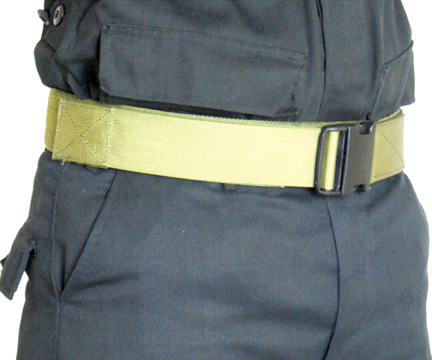
If we would make a STIFF 2 inch wide belt that has emergency rappel capabilities, a SUPER RIGGER BELT, this could be worn on the outside on the Nomex detachable combat jumpsuit and HANG GEAR FROM IT. If the belt is not wide enough or stiff like current Rigger's belts at the most you could do is hang a knife and a SERE kit pouch for escape & evasion, ehh recovery contingencies. A stiffer belt means a detachable buttpack, magazine pouches, etc. could be worn.
You simply wear a Cool-Aid vest under the jumpsuit and then drape then your body armor (IBA) on top with additional magazine pouches connected directly to it or a load bearing vest you prefer WITHOUT NEED OF ANOTHER BELT. You only wear 1 BELT AT THE WAIST.
OPTION B
OK. You may not like the combat jumpsuit for myriad reasons. Fine. Then WIDEN THE BELT LOOPS ON BDU pants so it can accept the Super Rigger belt. I pray to god you are wearing Nomex 2-piece BDUs if in an aircraft or a ground vehicle to protect against fire. Its your life.
All of the benefits of weight savings, simplicity and less range of motion restrictions at the waist are gained in this approach using Super Rigger belt and a 2-piece uniform.
The human body is hindered when we interfere with its range of motion. Draping a holster of any kind on the leg is going to incur a severe energy cost every time the leg muscles work. I do not buy into it at all. We should keep weight off the legs as much as possible. The ballistic protection of a 3 pound hunk of metal in one place on your leg is not adequate to protect the femoral arteries. We should stop screwing around and cover them with a minimalist flap of kevlar that would cinch down around the quadriceps muscles but flex with elastic. This is all the function impairment we should accept on the legs.
FEEDBACK!
A 1st TSG (A) member writes in:
"Thanks for the BDU Fix info we call them camouflage 'utilities' or 'cammies' for short."
"I agree that warm weather cammies function fine in cold weather. I've worn mine during cold weather ops in Korea, Norway, Chile and Minnesota. With careful layering they work just fine."
XXX XXXXX XXXXXXX,USNR
Group Aid Station
4th Medical Battalion
4th Force Service Support Group
Another response:
"Dear Sir,
"I have served with the Australian Army Reserve for seventeen years and experienced the change from heavy cotton drill uniforms to light weight poly-cotton uniforms. I also served as a firefighter with the South Australian Metropolitan Fire Service for thirteen years. Between these two jobs I have gained a bit of experience in the thorny area of working in the heat.
The Australian Army decided to change its style of uniform during the 80's. The issue "greens" were diabolical in hot weather, like wearing hessian sacking in an oven. The new Disruptive Pattern Combat Uniform (DPCU) was decided on in 1987 or 1988 and has been on issue for nearly ten years. The new DPCU pattern is a poly cotton mix and I can testify that this fabric is an improvement over the old greens.
I have been on exercise in temperatures ranging from below zero to greater than 45 degrees celsius, wearing both greens and DPCU patterns. In extreme heat lets face it you are hot and no fibre combination can change that. However the most beneficial quality of the DPCU is that any air movement around the Soldier will aid in cooling him/her down. Even slight breezes. The DPCU jacket is also a fairly loose fit which assists in keeping the Soldier cool.
Wearing combat gear causes the DPCU to be held against the body limiting air movement, which is vital in keeping the body cool at high temperatures. The Australian Army is still thinking about this Catch-22 situation but I think that I have an answer.
Under arm ventilation! I know that is not terribly radical, they use this idea in many modern sporting outdoors jackets and shirts. The Germans also used underarm and side body vents in camouflage smocks during WW2. But there is more recent proof concerning the validity of this concept.
Fire departments world wide have found that opening up the sides of a fire fighting tunics after a fire fighter leaves the fire zone greatly increased the cooling of the person wearing the kit. Bear in mind that fire fighters wear the equivalent of a Kevlar and Thinsulate quilt no matter what the daily ambient temperature.
I wont take up any more of your time. To sum up your idea of a light weight utility jacket is sound and if it was augmented with side ventilation then the troops could stay in their kit and stay relatively cool.
I like your web site, I hope this has been of interest."
Phil West writes:
"The old 'Velcro is noisy' argument always amuses me -only if you peel bits off it. If you are creeping up on someone and suddenly decide to change you unit insignia yes it's a problem (but you are probably too stupid to be given a weapon in this case anyway!) Velcro on a knife flap -bad idea. On a hood or insignia, fine. I seem to recall something about SAS man Cameron Spence actually replacing the zipper and buttons on his smock with velcro"
Kevin Paulson writes:
"Mike,
Supplycaptain.com has the capacity to have custom IR-reflective patches made, if I remember correctly. Also, this reminds me of the WW2 British practice of having DZ Flashes worn on the sleeves of their Dennison smocks so that at a glance you could pick your people out on a DZ. I like this idea, especially on the chance that people on convoy ops or on a large DZ will be working with unfamiliar people and not know who the SL, TL, CLS and so forth are. Perhaps a keyed symbol like the symbols used on the 101st's steel pots during WW2 might be a good idea? I am thinking that the only objections you'll hear from the potential customer base on this idea will be that the insignia might identify priority targets for enemy snipers. Otherwise, I'm on board with this.
Thanks!
Kevin"
An Army Field Artilleryman writes:
"That's an interesting idea.
One thing that I recommend adding to it would be a flap of fabric over the Position Identifier, that could be folded down over it (such as for the scenario where enemy snipers are looking for specific PI tags) --- that way, there's less risk of either losing or mixing up the PI tags. The flap could simply be sewn onto the existing uniform, with two small velcro tabs for the 'show' and 'hide' positions, respectively."
Our reply:
My first stab at it:
www.combatreform.org/ACUidentifierYcoverflap.ppt
Pvt Murphy's View
